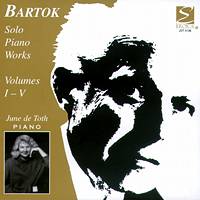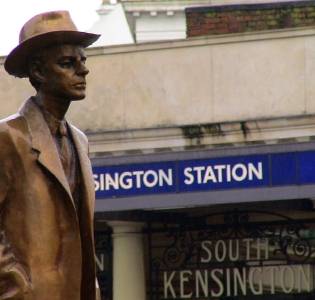
Revelatory success
June de Toth plays
Bartók piano music -
reviewed by
ROBERT ANDERSON'... a magisterial achievement.'
|

|
Having assisted in the French sense at the unveiling of a statue to Bartók
outside South Kensington station, I can say with confidence I should derive only
pleasure if it decided to come to dinner, particularly as it seems in urgent need
of a good meal. At least it has prompted me to get on with this review, especially
as I slept through most of his First String Quartet during the celebrations.
Location by the most elderly lines of London's malfunctioning underground system seems
less eccentric when one realises Bartók lodged nearby in a suitably blue-plaqued
house. The Peter Warlock Society was much involved in the statue project (hence two
playings of the Capriol Suite).

The Bartók statue at South Kensington tube station in London. Photo: Keith Bramich
|
Warlock (or Heseltine) had got Cecil Gray to write an article on Bartók
for his Sackbut magazine, and both visited Bartók in Budapest. Gray
was there first, and for quick identification in 1920 Bartók described his
appearance: 'I am very thin, have grey hairs, and am wearing spectacles.' He would
also be carrying a copy of The Sackbut. Maybe he was also wearing the
characteristic hat now on the head of the statue. Heseltine arrived in April 1921,
and was captivated at once. He told Delius that 'Bartók is quite one of the
most lovable personalities I have ever met', and continued to his Eton teacher in
considering him 'one of the half-dozen finest creative intelligences in the musical
world of today'. Both he and Gray coincided with Bartók in his middle period,
artistically acerbic and uncompromising.
In Gray's opinion, Bartók was 'one of the saints and fanatics of music'.
Kodály understood Gray's view of Bartók's 'harsh asceticism' in
creation, 'whether masochistic or sadistic'. Kodály described this as a phase
through which Bartók had to pass but from which he would emerge, as proved
the case. How does this affect the piano music? The only pieces properly freed from
Bartók's flagellatory period are in the Mikrokosmos set, which does
not feature here. On these CDs we have a judicious mix of crash-bang Bartók
and delectable offerings lasting sometimes less than a minute.
Continue >>
Copyright © 1 December 2004
Robert Anderson, London UK

|

